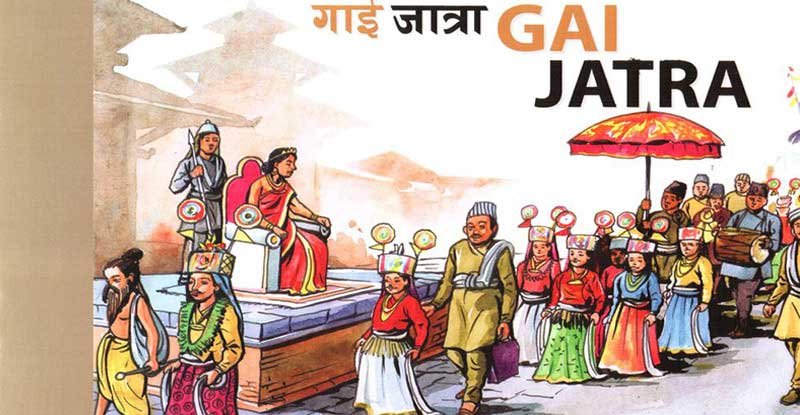Gai Jatra festival in Nepal- A detailed guide

- 19-Aug-2016
- 0
If you wander in the streets of Nepal’s capital for the Gai Jatra Festival, the procession of cows, you shall have mixed emotions. Hundreds of boys draped colorful clothing with faces smeared with mascara and painted as cows trot barefoot along the streets and be a part of a procession. You shall see them carrying the pictures of their family members or relatives deceased in the past year led by a cow or a boy dressed as the animal. This is done to make sure that their lost loved one has a place in heaven; steamed out of the belief that holy animal, cow, take their deceased relative(s) to heaven.
Besides the boys who symbolize cow during the procession, some other boys are dressed as girls in crimson blouses and saris. Friends and relatives offer milk, fruits, sweets, and beaten rice in a tray made of leaf to the participants of the procession.
One of the most popular festivals of this Himalayan nation, Gai Jatra generally falls in the Nepalese month of Bhadra or the months of July or August under the Gregorian calendar.
How did this festival actually start?
This festival has its root in the ancient period when people worshipped God Yamaraj, the God of Death, who is believed to decide the fate of people in their afterlife. However, the modern form of the Gai Jatra Festival is believed to have started in the medieval period, during the 17th century, when then King Pratap Malla of Kathmandu said to have invited the people to march in costumes and perform plays and other activities in front of his palace to make his beloved and grief-stricken wife smile after the death of their younger son.
The Queen, impressed by the stunts and procession, finally smiled and accepted that she isn’t the only person with death in the family. Locals believe that the culture of hosting parade and procession started and continued ever since that day.
Institutionalization of humor and satire in Gai Jatra
The inclusion of humor what started as an attempt to make the sad queen of Kathmandu smile has become a significant part of this festival. Over time, this festival has been used by people to ridicule and mock the evils, government offices, social problems, and issues.
With the presence of a seemingly autocratic government and restriction of speaking anything against the establishment, people took the liberty during the Gai Jatra Festival as the opportunity to speak against the rulers. After the reintroduction of democracy and the establishment of the Republic system of governance, artists and common people still stage various comedy shows, acts, dramas, and acts to express their dissatisfaction through satire and comedy. Thus during a long period of time, the tradition of including humor and satire is institutionalized in the festival of Gai Jatra.
Gai Jatra in different cities
Though Kathmandu is believed to be the source of this festival, other cities in Kathmandu valley also celebrate this festival. The festival passed on from one generation to the next, is considered to be the most memorable, enjoyable, and exciting in the medieval city of Bhaktapur. A bamboo-made chariot, known as Taha Macha, draped in cloth with a photo of the deceased person at the center is taken out in the procession. The locals and musicians follow the parade with a cultural dance known as Ghinta Ghisi. People dress up funnily with face masks and paintings on their faces. This dance continues till the festival of Krishna Ashtami.
Other neighboring cities of Patan and Kirtipur also celebrate this festival in different versions. While Patan celebrates it in a similar way as in Kathmandu, this is shadowed by a similar festival of Matayaa where locals participate with greater involvement. Kirtipur has a bit of variation in the celebration of Gai Jatra. Unlike in Kathmandu, where people take out procession dressed as gods and goddesses. The celebration is not only for the deceased relatives but also for the peace and harmony of family members and the whole of the city.
Thus, if you want to experience the medieval aged festival of Gai Jatra that blends in ancient traditions and medieval culture you are welcome. Share a part of people’s grief and enjoy the humor they share, you’ll certainly feel a lot better than simply wandering in this historical city. Happy Gai Jatra!




